Abstract
Traffic accidents are a major cause of death in Thailand. Thailand is ranked third in the world by the World Health Organization for traffic-related deaths. Decreasing road accidents is one of the Thailand National Strategy Goals and also the United Nations Sustainable Development Goals. Several traffic calming tools for school areas were reviewed for safety improvement. An approach of creating a three-dimensional piano-keyboard-styled pedestrian crossing was implemented. It used a one-point perspective technique to increase driver perception when approaching a pedestrian crossing. The assessment data were observed during 12 weeks of a school semester. A roadside camera was used to record vehicles during the morning peak, midday off-peak, and evening peak traffic. The vehicles’ average speeds were used to compare the pre- and post-installation safety. The results showed that after the new crossing was installed, vehicle speeds drastically decreased. After three weeks, vehicle speeds began to increase. After twelve weeks, the vehicle speeds had gradually increased toward the same level as before the installation. A z-test was performed at the 95% significance level (p-value 0.05), showing that the new crossing approach had only affected vehicle speed during the first three weeks post-installation. Driver familiarity behavior and faded paint were major factors in the results.
1. Introduction
Road accidents are one of the major causes of death in Thailand. With such a high number of traffic-related deaths, Thailand was ranked third in the world for traffic-related deaths by the World Health Organization [1]. Since the Thai government announced the 20-year National Strategic Master Plan in 2017, decreasing road accident deaths has become one of the five main issues of the Thailand Transportation Master Plan. United Nations also set Sustainable Development Goals (SDGs) to reduce road accident deaths and injuries (SDG target 3.6) and also to improve road safety relating to accessibility and sustainability matters (SDG target 11.2). Since then, road safety and accident prevention issues have become major research and development topics in Thailand.
Pedestrian and negligent driver behaviors are two major factors causing road accidents [2,3]. Children suffer the most from negligent drivers because of their inexperience and lack of knowledge of traffic [4]. Their injury and fatality rates in Thailand were 40.89 and 7.77 per 100,000 people, respectively, in 2018 [5]. Traffic speed reduction is recommended to increase driver awareness of pedestrians [6], which can significantly decrease accident rates in areas with children present.
Several traffic engineering tools, such as traffic calming, road designs, speed humps, pedestrian crossing lights, video cameras, sound warning systems, and pedestrian crossing flags, have been introduced to reduce traffic speed. Human perception techniques, such as road narrowing, are used to make drivers slow down. When traffic-calming tools are installed, drivers tend to reduce speeds automatically. Road geometric designs are another key factor impacting driving safety and mobility. The critical length of the road grade at 3.5–5% can reduce speed while maintaining traffic mobility [7]. Speed humps are another approach that can reduce driving speed by up to 20% [8]. Installation of LED pedestrian crossing lights improves visibility for both drivers and pedestrians [9]. Other traffic calming tools have been recommended and evaluated in different scenarios including CCTVs or closed-circuit television cameras [10,11], vibrated traffic calming [12,13], sound warning systems [14], and pedestrian crossing flags [15].
A novel approach to speed calming that was suggested uses an optical illusion over pedestrian crossings to increase drivers’ awareness of their vehicles. Linear perspective is used by artists to create three-dimensional illusion images on a flat surface, such as a three-dimensional crosswalk (3D crosswalk) [16]. The illusion images are seen to be floating above the ground and obstructing the road, making drivers slow down automatically [17]. This technique has been implemented as a speed calming tool in several countries such as China, Greece, Iceland, India, Kyrgyzstan, New Zealand, Russia, South Africa, Ukraine, the United Kingdom, and the United States. Three-dimensional crosswalk assessments were explored by several researchers. Driver reactions were compared between the traditional crosswalk and 3D crosswalks. The results concluded that driver behaviors had longer response times on a 3D crosswalk over the traditional crosswalk [18]. The drivers tended to reduce vehicle speed, both intentionally and unintentionally, when seeing three-dimensional objects on the road [19]. Square or cuboid shapes were more effective illusionary images than other shapes, such as triangular prisms, for traffic calming [20].
The objective of this research was to implement a new three-dimensional pedestrian crossing in a school area with a new design, different from the typical cuboid shape. After the installation, we assessed the new design, highlighting factors such as vehicle type, time of day, and peak and off-peak periods according to the safe walking framework [21].
2. Methodology
An experimental project of urban road improvement was implemented at Chiang Mai University Demonstration School during the school semester. A three-dimensional piano-keyboard-styled pedestrian crossing (3DPK crossing) was installed and painted over the existing zebra crossing. The purpose of the 3DPK crossing is to be conspicuous and unforeseen, thereby increasing drivers’ awareness and making them slow down.
A roadside video camera was used as a traffic-monitoring tool for measuring the individual speeds of vehicles passing a point at the crossing stop line. The framerate of the camera was 25 frames per second (FPS). A video camera recorded the time when the front of the vehicle passed the C1 point (start of timing) and C2 point (end of timing) as shown in Figure 1. The distance between C1 and C2 was the crossing length. The speed of each vehicle was calculated by dividing the distance traveled by the time.
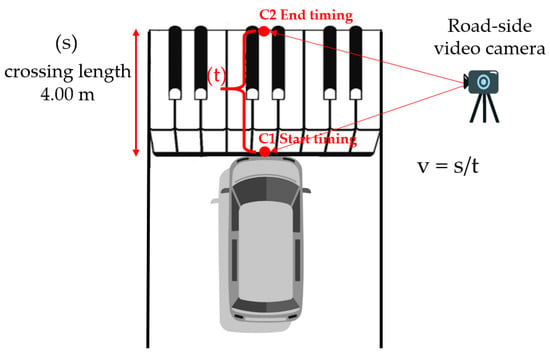
Figure 1.
Speed measurement at crossing.
The average speed was calculated from all records of vehicles passing the crossing. Vehicle speeds were calculated for pre- and post-installation, and vehicles were categorized as motorcycles or personal cars.
The survey was conducted in both peak and off-peak traffic periods. Morning and evening peaks were conducted between 7–8 am and 3–4 pm, respectively. Afternoon off-peak or midday was conducted between 12–1 pm. The traffic data were retrieved for a total of 1 + 12 weeks ranging from a week before the 3DPK crossing installation and 12 weeks after the installation. Samples sizes of 150 motorcycles and 150 personal cars, in each peak period, were used for statistical comparative purposes.
3. Existing Pedestrian Crossing
The existing pedestrian crossing was a 7.43 m zebra crossing, as displayed in Figure 2. It was installed on an undivided two-lane road in front of the Chiang Mai University Demonstration School.
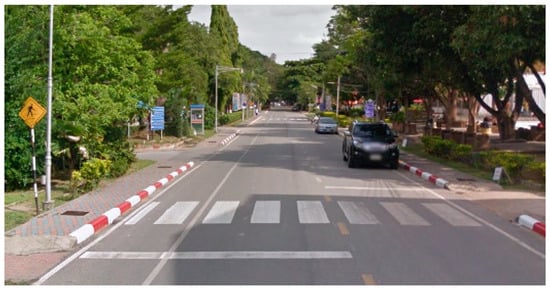
Figure 2.
The existing pedestrian crossing in front of the school.
Vehicular average speeds measured for motorcycles and personal cars were 36.14 and 33.89 kph. The recorded data of the average vehicle speed were higher than the school’s speed limit, which was 30 kph [22].
4. Drawing Perspective Technique
The drawing perspective technique was used for the 3DPK crossing development. It created a realistic three-dimensional sense from a flat surface. One-point perspective was used typically for road or railway images and drawings, which the viewer’s line of sight is perpendicular to the scene. The one-point perspective has a vanishing point on the horizontal line, which all parallel lines converge to this point, as displayed in Figure 3. Therefore, the technique was selected to increase driver perception when approaching perpendicularly to a pedestrian crossing [16].

Figure 3.
One-point perspective technique showing two parallel lines converging to the vanishing point at eye level (horizon line) [16].
The 3DPK crossing was sketched using the one-point perspective technique. Each piano key was drawn as a cuboid with parallel lines connecting to the vanishing point, as illustrated in Figure 4. The top edges of the cuboid were drawn from receding parallel lines to the vanishing point. Then the hidden receding lines were drawn to the cuboid’s bottom edges. Finally, the vanishing point location was set based on the eye level of drivers sitting behind the wheel [16].
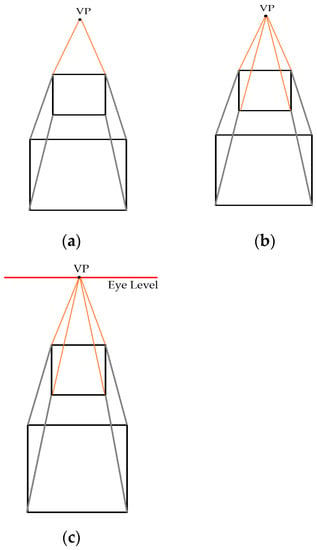
Figure 4.
Drawing perspective technique steps: (a) Receding lines drawn to the vanishing point (VP), (b) hidden receding lines drawn to the vanishing point, and (c) vanishing point set at the eye level [16].
5. Three-Dimensional Piano-Keyboard-Styled Pedestrian Crossing
A three-dimensional piano-keyboard-styled pedestrian crossing (3DPK crossing) was designed similar to the zebra crossing with white and black stripes and a noticeable appearance. The 3DPK vanishing point and horizon line were set to 1.20 m, the average behind-the-wheel eye level in Thailand [23]. The distance between the vanishing point and the 3DPK crossing was 20 m in relation to the braking distance of a vehicle’s speed at 40 kph. The 3DPK crossings dimensions are illustrated in Figure 5.
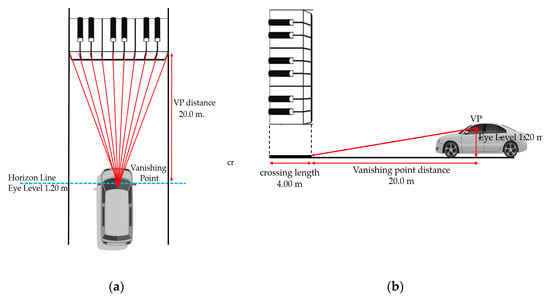
Figure 5.
The vanishing point of piano keyboard 3D image pedestrian, the top view (a) and the side view (b).
Figure 6 displays 3DPK with details adapted from the pedestrian crossing design of the Thailand Manual of Application for Traffic Control Devices at Crossing in Urban Community and Schools Area [24]. The width of the crossing was 4.00 m over a two-lane road. White stripes (natural piano keys) were 0.80 by 4.00 m in size. Black stripes (sharp and flat piano keys) were 0.37 by 2.80 m in size. The pseudo depths of the white keys and black keys were 1.00 and 0.50 m, according to the perspective design.

Figure 6.
A three-dimensional piano-keyboard-styled (3DPK) crossing dimensions in perspective design.
6. Installation of 3DPK Crossing
The 3DPK crossing installation process, as displayed in Figure 7, started by removing and cleaning the existing zebra crossing paint. Then the piano-keyboard graphic was sketched on the road surface. Paint materials, including thermoplastic color, white Portland cement, glass beads, and 0.5% luminol, were mixed together. Afterward, the mixture was painted on the road. Figure 8 demonstrates the 3DPK crossing over the undivided two-lane roadway in front of the school.

Figure 7.
Installation of 3DPK crossing: (a) Removing existing zebra crossing paint, (b) road sketching before paint, (c) mixing materials, and (d) applying new paint.

Figure 8.
The 3DPK crossing painted in front of the school.
7. Results and Discussions
7.1. Pre- and Post-Installation Vehicle Speeds
Motorcycle speeds and personal car speeds approaching the 3DPK crossing were observed. Figure 9 displays the average speeds for motorcycles and personal cars before and after the installation. Vehicle speeds dropped significantly after the first week for personal cars and the first two weeks for motorcycles. Then the speeds slightly increased for both vehicle types, bouncing back and surpassing the initial level. The chart below also indicates that the speed of a motorcycle was higher than that recorded of a personal car within the school zone.

Figure 9.
The average speeds of motorcycles and personal cars approaching 3DPK crossing.
Motorcycle speed was 36.1 kph for the average speed prior to the installation. A day after the installation, the speed was significantly decreased by around 10%. The downward trends continued into the second week. Then they bounced back to the same level as those before the installation.
Personal car speed was 33.9 kph for the average speed before the installation. A day after the installation, the speeds decreased by around 10%. The downward trend continued through the first week after installation, then, it bounced back to the same level in the fourth week and continuously increased until the final week. However, the limitation of the pre- and post-study at one spot without a control site may have biased the results from confounding factors [25]. Additionally, the effect of the 3DPK may surprise the following driver and lead to a rear-end collision due to sudden braking [26].
The data displayed the speeds, along with standard deviation, and a statistical z-score value of 95 confidence intervals of motorcycles and personal cars, as shown in Table 1 and Table 2. A z-test is a statistical test used to determine whether two population means (pre- and post-installation vehicle speeds) are different when the variances are known and the sample size is large. The speed data have a normal distribution.

Table 1.
The average speed of motorcycles approaching 3DPK crossing.

Table 2.
The average speed of personal cars approaching 3DPK crossing.
This study applied a z-test to compare, one by one, the differences before painting and one-day installing after installation, before painting and one-week, before painting and two-week, before painting and three-week, before painting and four-week, before painting and eight-week, and before painting and 12-week.
The research hypothesis is that the mean speed or average speed of motorcycles or personal cars post-installation, is less than that of the pre-installation. The null hypothesis is that there is no change in average speeds. Since the p-value is less than 0.05, it can accept the research hypothesis and conclude based on our results that the average speed of post-installation is less than pre-installation. After three weeks of installation, the p-value is more than 0.05, it can accept the null hypothesis and conclude based on the result that no change in average speed. It showed that the effect of the 3DPK crossing on driver speed was only temporary.
7.2. Vehicle Speed by the Time of Day
Vehicle speeds were recorded and analyzed from different time periods, ranging from the morning peak, midday off-peak, and evening peak. Motorcycle data are displayed in Figure 10 and personal car data in Figure 11. The dashed lines represent average speeds.

Figure 10.
Motorcycle speeds approaching 3DPK.
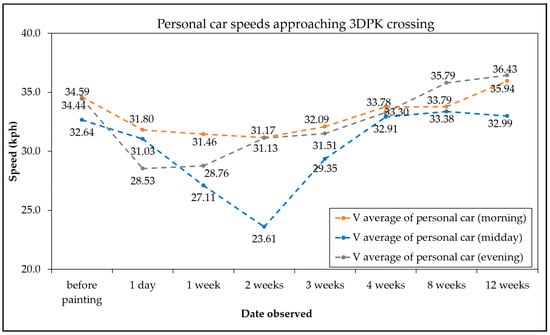
Figure 11.
Personal car speeds approaching 3DPK.
Motorcycle speeds, during midday off-peak, were the lowest. However, the speed during evening peak was the highest. After the 3DPK crossing was installed, the speed during morning peak and midday off-peak had significantly decreased. The evening peak had only slightly decreased. After two weeks, the average speeds during the evening peak continued to drop to their lowest point and then bounced back to the same level in the following weeks. The speeds slightly increased back to the initial pre-installation level in the final week.
Personal car speeds, during midday off-peak, were the lowest. Unlike the motorcycle speeds, which, during the morning peak, were the highest. After the 3DPK crossing was installed, the speeds during the evening peak and midday off-peak were significantly decreased, while the speed during the morning peak, was only slightly decreased. After two weeks, the average speed during the midday off-peak continued decreasing to its lowest and then proceeded to bounce back the following weeks. The speed slightly increased back to the same initial level in the final week.
The detailed data are separated into two tables. Table 3 is for motorcycles and Table 4 is for personal cars. A z-test was performed at the 95% significance level (p-value 0.05) to compare one by one between before painting and post-installation according to the time of day. The research hypothesis is that the mean speed or average speed of motorcycle or personal car of pre-installation is more than post-installation. The null hypothesis is that there is no change in average speed. Since the p-value is less than 0.05, it can accept the research hypothesis and conclude, based on our results, that the average speed of post-installation is less than pre-installation. After three weeks of installation, the p-value is more than 0.05, it can reject the research hypothesis and conclude based on the results that there was no change in average speed. It showed that the 3DPK crossing approach was only effective for the first three weeks after installation.

Table 3.
The motorcycle speeds approaching 3DPK crossing at different time periods.

Table 4.
The personal car speeds approaching 3DPK crossing at different time periods.
7.3. Perception of 3DPK Crossing after Faded Paint
Over the 12-week observation, the paint of the 3DPK crossing had faded and was covered in dirt. Figure 12 displays the 3DPK crossing during the daytime after the first, fourth, eighth, and twelfth week of its installation. The crossing was still visible, but the perception of a three-dimensional perspective was not clear. Figure 13 shows the 3DPK crossing during the nighttime. The surface reflection was completely gone after the twelfth week. It was highly recommended to do routine maintenance and surface cleaning every two to three months.

Figure 12.
3DPK crossing during daytime showing faded paint: (a) One week after installation, (b) four weeks after installation, (c) eight weeks after installation, and (d) 12 weeks after installation.

Figure 13.
3DPK crossing during nighttime showing faded paint: (a) One week after installation, (b) four weeks after installation, (c) eight weeks after installation, and (d) 12 weeks after installation.
8. Conclusions
The three-dimensional piano-keyboard-styled pedestrian crossing (3DPK crossing) implementation was done in a school zone. It used the one-point perspective technique for safety improvement purposes. It created a sense of depth similar to that of a large piano keyboard, which spanned over a two-lane road surface. As a traffic calming tool, it reminded the approaching drivers of the pedestrian crossing. The assessment was done by observing vehicle speeds in both motorcycles and personal cars. The observations were recorded at different time periods, which ranged from morning peak, midday off-peak, and evening peak, over the duration of 12 weeks. The results showed that vehicle speeds decreased significantly after the 3DPK crossing was installed for the first few weeks. After that, the vehicle speeds slightly increased back to the same level as before the installation. Considering the times of day, motorcycle speeds during evening peak and personal car speeds during morning peak were not affected significantly by the installation.
A z-test was performed at the 95% significance level (p-value 0.05). It showed that the 3DPK crossing approach had affected only the first three weeks. Both driver familiarity and faded paint were identified as two reasons for the effect of the 3DPK crossing on driver speed being only temporary. Unfortunately, the confound cannot be disentangled in the present study. In future research, the piano shape and the different styles other than piano-style might be tested for different desired results and will be applied to other areas, such as hospitals, playgrounds, and community areas.
Author Contributions
Conceptualization, P.P. and T.P.; methodology, P.P. and T.P.; investigation, T.P.; data curation, T.P. and P.N.; writing—original draft preparation, P.P., M.K., T.P. and P.N.; writing—review and editing, P.P. and M.K.; visualization, P.P. and M.K.; supervision, P.P., M.K., and P.N.; project administration, P.P. All authors have read and agreed to the published version of the manuscript.
Funding
This research received no external funding.
Acknowledgments
The authors gratefully acknowledge the installing staffs from the Department of Rural Roads, Thailand, the materials for road marking from 3M Thailand Co., Ltd., TOA PAINT Thailand Co., Ltd. and The Siam Cement Group Public Company Limited, and the installation site from Chiang Mai University Demonstration School, Faculty of Education, Chiang Mai University. This research work was partially supported by Chiang Mai University.
Conflicts of Interest
The authors declare no conflict of interest.
References
- Global Status Report on Road Safety. Available online: https://www.who.int/violence_injury_prevention/road_safety_status/2018/en/ (accessed on 10 August 2020).
- Mako, E.; Szakonyi, P. Evaluation of human behaviour at pedestrian crossings. Transp. Res. Procedia 2016, 14, 2121–2128. [Google Scholar] [CrossRef]
- Bella, F.; Silvestri, M. Effects of safety measures on driver’s speed behavior at pedestrian crossings. Accid. Anal. Prev. 2015, 83, 111–124. [Google Scholar] [CrossRef]
- Hart, J. Driver Behavior on Campus; Robert Morris University: Pittsburgh, PA, USA, 2009. [Google Scholar]
- Bureau of Highway Safety, Department of Highways, Thailand. Traffic Accident on National Highways in 2018. Available online: http://bhs.doh.go.th/download/accident (accessed on 11 August 2020). (In Thai).
- Sołowczuk, A.; Gardas, P. Effect of the Parking Lane Configuration on Vehicle Speeds in Home Zones in Poland. Sustainability 2020, 12, 588. [Google Scholar] [CrossRef]
- Zhang, X.; Xu, J.; Liang, Q.; Ma, F. Modeling Impacts of Speed Reduction on Traffic Efficiency on Expressway Uphill Sections. Sustainability 2020, 12, 587. [Google Scholar] [CrossRef]
- Jägerbrand, A.K.; Johansson, M.; Laike, T. Speed Responses to Speed Humps as Affected by Time of Day and Light Conditions on a Residential Road with Light-Emitting Diode (LED) Road Lighting. Safety 2018, 4, 10. [Google Scholar] [CrossRef]
- Patella, S.M.; Sportiello, S.; Carrese, S.; Bella, F.; Asdrubali, F. The Effect of a LED Lighting Crosswalk on Pedestrian Safety: Some Experimental Results. Safety 2020, 6, 20. [Google Scholar] [CrossRef]
- Noh, B.; No, W.; Lee, J.; Lee, D. Vision-Based Potential Pedestrian Risk Analysis on Unsignalized Crosswalk Using Data Mining Techniques. Appl. Sci. 2020, 10, 1057. [Google Scholar] [CrossRef]
- Amado, H.; Ferreira, S.; Tavares, J.P.; Ribeiro, P.; Freitas, E. Pedestrian—Vehicle Interaction at Unsignalized Crosswalks: A Systematic Review. Sustainability 2020, 12, 2805. [Google Scholar] [CrossRef]
- Niu, S.F.; Liu, Y.J.; Wang, L.; Li, H.Q. Effects of Different Intervention Methods on Novice Drivers’ Speeding. Sustainability 2019, 11, 1168. [Google Scholar] [CrossRef]
- Li, L.; Zhang, D. Merging Vehicles and Lane Speed-Flow Relationship in a Work Zone. Sustainability 2018, 10, 2210. [Google Scholar] [CrossRef]
- Yan, X.; Wang, J.; Wu, J. Effect of In-Vehicle Audio Warning System on Driver’s Speed Control Performance in Transition Zones from Rural Areas to Urban Areas. Int. J. Environ. Res. Public Health 2016, 13, 634. [Google Scholar] [CrossRef] [PubMed]
- Clark, S.; Coughenour, C.; Bumgarner, K.; de la Fuente-Mella, H.; Reynolds, C.; Abelar, J. The Impact of Pedestrian Crossing Flags on Driver Yielding Behavior in Las Vegas, NV. Sustainability 2019, 11, 4741. [Google Scholar] [CrossRef]
- Artists Network, Understanding Linear Perspective Drawing. Available online: https://www.artistsnetwork.com/how-to-draw-perspective/ (accessed on 30 October 2016).
- Hasson, P.; Struve, B.; Chen, C.; Brewer, J.; Doctor, M.; Harrison, K.; Maifield, D.; Matzke, M.; Merritt, G.; Mooney, R. Evolving Geometric Design Decision-Making in the United States. In Proceedings of the U.S. Country Report for the 5th International Symposium on Geometric Design, Vancouver, BC, Canada, 22–24 June 2015. [Google Scholar]
- Rebelo, F.; Cerqueira, D.; Freixinho, I.; Noriega, P. Evaluation of 3d crosswalks design. Adv. Intell. Syst. Comput. 2019, 777, 89–96. [Google Scholar]
- Burlov, V.; Gomazov, F. Method of mathematical justification for using 3D zebra crossing. Transp. Res. Procedia 2018, 36, 95–102. [Google Scholar] [CrossRef]
- Trifunović, A.V.; Čicević, S.J.; Lazarević, D.M.; Dragović, M.S.; Vidović, N.D.; Mošić, M.R.; Otat, O.V. Perception of 3D virtual road markings—Based on estimation of vehicle speed. FME Trans. 2019, 47, 360–369. [Google Scholar] [CrossRef]
- Rahman, M.L.; Moore, A.; Smith, M.; Lieswyn, J.; Mandic, S. A Conceptual Framework for Modelling Safe Walking and Cycling Routes to High Schools. Int. J. Environ. Res. Public Health 2020, 17, 3318. [Google Scholar] [CrossRef] [PubMed]
- Department of Rural Roads. Standard Drawing for Department of Local Administration; Department of Rural Roads: Bangkok, Thailand, 2016; ISBN 978-974-9848-75-3. (In Thai) [Google Scholar]
- Pedpradab, P.; Rudjanakanoknad, J. Eye Height and Reaction Time for Thai Drivers. In Proceedings of the 19th National Convention on Civil Engineering, Khon Kaen, Thailand, 14–16 May 2014. (In Thai). [Google Scholar]
- Department of Highways. Manual of Application for Traffic Control Devices at Crossing in Urban Community and Schools Area; Department of Highways: Bangkok, Thailand, 2011. (In Thai) [Google Scholar]
- Elvik, R. The importance of confounding in observational before-and-after studies of road safety measures. Accid. Anal. Prev. 2002, 34, 631–635. [Google Scholar] [CrossRef]
- Olejnik, K.; Łopuszyński, M.; Nowacki, G.; Zakrzewski, B. Testing of the drivers ability to assess the distance on the road while driving. In International Conference on Reliability and Statistics in Transportation and Communication; Springer: Cham, Switzerland, 2018; pp. 489–499. [Google Scholar]
© 2020 by the authors. Licensee MDPI, Basel, Switzerland. This article is an open access article distributed under the terms and conditions of the Creative Commons Attribution (CC BY) license (http://creativecommons.org/licenses/by/4.0/).